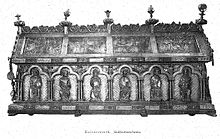Suitbertus shrine
The Suitbertus shrine in Düsseldorf - Kaiserswerth is a reliquary made of gilded copper sheet over an oak wood core, which was created in 1264 in the shape of a single-nave church. It contains the relics of St. Suitbert and St. Willeicus and belongs to the church treasury of the Basilica of St. Suitbertus .
description
In Die Kunstdenkmäler der Stadt und der Kreis Düsseldorf, Paul Clemen describes the work of art in detail, which is a combination of late Romanesque, early Gothic and French forms.
Gable ends
The gable ends show different figures. On one gable side there is a seated figure of Suitbertus on a throne under a cloverleaf arch , who holds a star in his left hand and a crosier in his right hand. On the right side of the saint of the figures of the will domo Pippin and St. Plectrudis flanked. Above, above the clover-leaf arch, the half-figures of three angels can be seen in the semicircles. The gussets between the clover leaf arch are filled with "Email brun". The inscriptions read: "REGINA PLECDRUDIS * SANCTUS SUITBERTUS * REX PIPPI (nus)." On the other side of the gable is a seated figure of Mary on a throne in the middle, holding an apple in her right hand. A clothed child sits on her left knee. Mary is flanked by two smaller, female figures of saints who are holding cans in their hands. A Latin inscription can be read: "Above the cloverleaf arch which bears the inscription in pits on a dark blue ground: AVE MARIA GRATIA PLENA DOMINUS TECUM, BENEDICTA TU IN MULIERIBUS." The figures of God the Father and two angels can be seen in three semicircles. The reason is worked out with " Email brun ".
Long sides
The two long sides each show six seated apostles under cloverleaf arches. They are all equipped with books, some with additional symbols. Above the names of the apostles: “The arches in pit enamel on an alternating dark and light blue background bear the names of the twelve apostles - left SS. Petrus, Paulus, Bartholomeus, Andreas, Matheus, Johannes, right SS. Jacobus, Thomas, Simon , Philip, Matthias, Jacobus min. -, each rest on two Romanesque, ornamented columns with gusset bases and Klechkapitellen, behind which there are stripes with enamel brun. "In the spandrels there are the" embossed three-quarter figures of angels with books, rolls of tape or censer in high relief. "
cover
The lid, which has the shape of a roof, is lavishly decorated: it “shows eight embossed representations in flat bas-relief, on the left the Annunciation, birth, adoration of the Magi, representation in the temple, on the right baptism, crucifixion (again) resurrection, ascension. At the end of the ridge is a beautifully stylized vine tendril with large bunches of grapes, crowned by five richly decorated knobs with crystal balls, some of whose attachments and sockets are again. Of the leaf friezes that adorn the gable ends, only the one above the Madonna is old. "
Relics
The shrine contains the relics of St., who died on March 1, 713 in Kaiserswerth. Suitbert and St. Willeicus. The relics were solemnly transferred on July 6, 1267. Inside the shrine, these are in a simple, wooden box and are wrapped in silk. There are small lead tablets with the Latin inscription in uncials: “ISTAE SUNT RELIQUIAE BEATI SWIBERTI CONFESSORIS, QUARUM FACTA EST HAEC TRANSLATIO AD MCCLXIV IN OCTAVA APOSTOLORUM PETRI ET PAULI TEMPORE URBANI PAPAE QUARTI. ISTAE SUNT RELIQUIAE BEATI WILLEICI CONFESSORIS, QUAE EODEM TEMPORE SUNT TRANSLATE. "
Art historical significance
The shrine belongs to the "series of important medieval reliquary shrines in the Rhine-Maas area". The shrine forms the end of the series of Lower Rhine shrines from Aachen, Deutz, Cologne , Siegburg opened by the Tumba von Xanten . In terms of structure and decoration, the shrine shows the formal language of the Karlsschreine from Aachen, which was completed in 1215. While the skeleton is still late Romanesque, the figures are already early Gothic. The figures of St. Suitbertus and the figure of Mary are reminiscent of French sculptures. The enamel work shows that the shrine belongs to the Cologne group of shrines.
Individual evidence
- ↑ a b c d e f g h i Paul Clemen (ed.): The art monuments of the Rhine province. Third volume. I. The art monuments of the city and the district of Düsseldorf. On behalf of the Provincial Association of the Rhine Province . Düsseldorf 1894, p. 137f
- ↑ http://gemeinden.erzbistum-koeln.de/pfarrverband_angerland_kaiserswerth/kirchen/stsuitbertus/heiliger_suitbertus/

